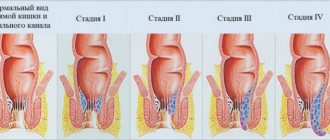A condition in which a burning sensation is felt in the epigastric region is often found among young mothers who practice natural feeding of a newborn baby. This pathological symptom may be accompanied by additional sensations such as nausea, pain in the epigastric region, discomfort, stool disorders, decreased or increased appetite.
Considering that not all medications are available for a nursing woman to take, she should familiarize herself with the main causes of heartburn, as well as methods for safely eliminating the disease.
Cervical dilatation before childbirth - what is it and how is it checked?
Every woman dreams of safely carrying and giving birth to a healthy baby. But few people realize that one of the factors for a favorable outcome is a healthy cervix. It plays a vital role in prolonging pregnancy and preserving the fetus. The cervix is one of the conditionally separated parts of the uterus. From above, the cervix passes into the isthmus of the uterus, from below it is connected to the vagina through the vaginal fornix. The cervical canal passes through the thickness of the cervix. It connects the uterine cavity to the vagina. The exit of the canal on the vaginal part of the cervix is called the external os, and into the uterine cavity is called the internal os.
Normally, the cervical canal is filled with cervical mucus, which performs a protective and barrier function. This is a light, transparent, extensible liquid (the extensibility of cervical mucus depends on the woman’s hormonal background). Cervical mucus prevents pathogenic agents (bacteria, fungi, viruses) from entering the uterine cavity, preventing infection of the amniotic membranes and fetus. The cervix itself acts as a sphincter, holding the fetus in the uterine cavity. The condition of the cervix is assessed during a vaginal examination and speculum examination of the cervix. A healthy cervix before pregnancy and before its maturation is determined by a length of 3-4 cm, dense, tilted posteriorly, the cervical canal is closed. In multiparous women, after surgical treatment, injuries, variations in its changes are possible. Which may increase the risk of miscarriage.
That is why it is so important to conduct regular medical examinations with an obstetrician-gynecologist and prepare in advance for conception. If certain unfavorable factors (diseases) are identified, undergo treatment in a timely manner in order to minimize the risks of complications both during pregnancy and during the birth period. Scars after surgical interventions on the cervix, scars after bougienage of the cervical canal, shortening after excision of the cervix - all this creates the precondition for complications both during pregnancy and childbirth. Dilatation of the cervix before childbirth occurs against the background of changes in the woman’s body, which are aimed at preparing for childbirth. So what's going on? How does the body prepare for childbirth? As labor approaches, a woman's production of progesterone, the hormone responsible for maintaining pregnancy, decreases.
Against this background, the production of estrogen increases. Estrogens activate metabolic processes in the muscular layer of the uterus, increase their contractility, and stimulate the formation of prostaglandins. Prostaglandins are lipid active compounds whose action resembles that of hormones. They are formed in the placenta and play a decisive role in the development of labor. Arachidonic acid plays a decisive role in the formation of prostaglandins. It is an essential fatty acid and is classified as an omega-6 essential fatty acid. That is why a pregnant woman’s diet should include foods containing omega-6. Yes, arachidonic acid is also synthesized in the body, but its concentration is not always enough to “start” the process. The ripening of the cervix occurs gradually and unnoticed by the woman.
What is meant by this process?
The cervix becomes soft and loose. Its length is shortened to 1.5-1 cm. The cervix unfolds and is already aligned with the axis of the pelvis (previously it was deviated posteriorly). The cervical canal begins to open and freely passes the finger to the internal os or beyond the internal os (in multiparous women). As the cervical canal opens, the mucus plug comes away. Often women notice its departure. The degree of cervical ripening is assessed by an obstetrician-gynecologist during a vaginal examination. The degree of cervical ripening is assessed in points, based on the Bishop table.
Causes
The mechanism for the formation of this condition is the increased production of gastric juice containing hydrochloric acid. This chemical compound has an aggressive effect on the inner surface of the stomach and part of the esophagus, which is accompanied by a burning sensation and pain in the epigastric region. The following factors can provoke excessive production of acid content in a nursing woman:
- Hormonal reorganization of the body. From the moment the baby is conceived, the mechanism of global hormonal changes is launched in the female body. When a woman becomes a mother, the level of hormones such as progesterone and prolactin increases in the body, which has a relaxing effect on smooth muscle tissue and stimulates the formation of breast milk. The result of this process is a decrease in the tone of the esophageal sphincter, located at the point of its transition to the stomach. Thus produced hydrochloric acid has access to the esophageal part, which does not contain a protective mucous coating. This condition is referred to as gastroesophageal reflux;
- Nature of nutrition. Young mothers who have made a choice in favor of natural feeding of the child often follow an irrational diet. Daily snacks on the go, dry food and other unfavorable factors have a detrimental effect on the digestive system as a whole. Lack of balanced nutrition negatively affects not only the young mother’s body, but also the health of the child, who does not receive enough nutritional components from mother’s milk;
- Decrease in the body's defenses. During the period of bearing a child, a woman’s immunity is in a depressed state, which is a natural mechanism for pregnancy. Against the background of reduced immunity, chronic diseases that were in remission often worsen in a nursing woman. Such diseases include pathologies of the digestive tract;
- Impact of a stress factor. In the postpartum period, the main task of a woman is to care for her newborn baby. Caring for a baby and worries related to his well-being have a stressful effect on the female body, as a result of which the young mother develops anxiety symptoms;
- Excess body weight. During pregnancy, about 60% of women experience excessive weight gain. This process is accompanied by stretching of the stomach walls and relaxation of the gastroesophageal sphincter. Such conditions are favorable for the formation of gastroesophageal reflux.
How to speed up the dilatation of the cervix before childbirth?
These are the questions most pregnant women ask. Oddly enough, the answer is very banal - lead a healthy lifestyle. A balanced diet that includes foods containing omega-3 and omega-6 – essential fatty acids. They are a source of arachidonic acid, from which prostaglandins are formed, which trigger labor. These acids are also necessary for the proper development of the fetal brain. Sources include fatty fish, eggs, meat, nuts, unrefined sunflower oil (dress salads with it). Most pregnant women complain of constipation, which can also be a reason for a delay in the development of regular labor. Include in your diet foods containing fiber (for example: bran bread, oatmeal, buckwheat...), fermented milk products. Prunes are a great help in coping with the problem. But its consumption should not exceed 2-4 pcs. per day (may increase intestinal motility). Don't forget about vegetables. But be careful with fruits. They contain large amounts of fructose, which can increase fermentation in the intestines.
It is important!
Naturally, you should not exclude them - stick to the golden mean.
It is great if a woman led an active lifestyle during pregnancy. This could be classes in the pool, with a fitball, or yoga classes. The main thing is that all classes are carried out under the supervision of an experienced trainer and with the permission of an obstetrician-gynecologist. Physical activity helps to activate metabolic processes, enrich the body with oxygen, create an elevated mood, ensure restful sleep, normalize hormonal levels, and strengthen the muscles of the press and perineum. All this contributes to the correct and timely launch of labor. Regular house cleaning will also have a beneficial effect. Yes, and that's a plus. Wash the floor, vacuum, wipe off dust at 38 weeks - this will help you. If you do not live on a high floor and the house has an elevator, then use the stairs. It is better to climb slowly, without haste, taking short breaks. But lifting weights is undesirable. Give this activity to your spouse. Don't forget about your sex life. It will have a beneficial effect in the later stages of pregnancy. The release of pleasure hormones and oxytocin will speed up the long-awaited meeting with the baby. The seminal fluid of sperm contains prostaglandins, which are essential in initiating labor. Be sure to discuss the possibility of intimacy with your obstetrician-gynecologist. Unfortunately, there are a number of contraindications in which it is worth delaying receiving positive emotions until the end of the late postpartum period. For example, placenta previa, isthmic-cervical insufficiency.
How to properly deal with heartburn during breastfeeding?
The lactation period has its own characteristics and imposes certain dietary taboos on the nursing mother.
The first step to getting rid of heartburn is to establish a proper diet and rest regimen. Following the rules of the daily routine is quite difficult, because the child requires attention, and his desires and needs are always unpredictable. Therefore, despite the occurrence of unforeseen circumstances, a woman should think not only about the baby, but also about her health.
There are several important points that should be observed when symptoms of heartburn occur in nursing mothers:
- Additional relaxation of the esophageal sphincter occurs with excessive consumption of chocolate, fried and fatty foods. They need to be reduced or eliminated from the diet altogether.
- Since heartburn occurs immediately after eating, it is better for a woman not to lie down for the first 1.5-2 hours.
- You need to eat in small portions. It is better to divide meals into 5-6 times. In this case, the interval between them should be 2-2.5 hours. You need to eat slowly, chewing every piece of food thoroughly.
- You need to sleep with your upper body elevated; to do this, just use another pillow.
Since during breastfeeding, a woman should limit the consumption of certain foods and medications. In this situation, young mothers resort to folk remedies for treating heartburn symptoms. Here are some of the most effective and safest for children.
1. Milk A couple of sips of milk relieve heartburn within 2-3 minutes. This product does not harm the baby at all and will not affect lactation in any way.
2. Nuts Several nuts (hazelnuts, almonds, walnuts) help with heartburn if you eat them 5 minutes after eating. Nuts can also be replaced with seeds in small quantities.
3. Mint Mint tea in the amount of one or two small glasses will perfectly relieve the burning sensation and will not spoil the taste of a nursing mother’s milk.
At what point can softening of the cervix be dangerous?
The softening of the cervix before childbirth begins several weeks and days before the baby arrives. The danger comes from shortening the cervix by less than 2.5 cm and or dilating the cervical canal by 1 cm throughout its entire length before 37 weeks. This condition is called isthmic-cervical insufficiency. Changes in the cervix are asymptomatic, and the woman does not make any complaints. With the development of this pathology, the risk of miscarriage increases significantly - spontaneous miscarriage (before 22 weeks of pregnancy) or spontaneous premature birth (after 22 weeks of pregnancy). In modern times, ultrasound helps in diagnosing isthmic-cervical insufficiency.
There are many predisposing factors in the development of this pathology - infectious processes of the genital organs, hormonal disorders, cervical scars, shortening of the cervix (for example: congenital or after excision of the cervix), insufficient collagen production, genetic predisposition. To correct isthmic-cervical insufficiency, they resort to suturing the cervix or installing an obstetric pessary (the decision is made individually and depends on a number of factors).
Subsequently, regular monitoring of smears for flora is carried out, and, if necessary, sanitization of the vagina to prevent the development of an infectious and inflammatory process. In most cases, women carry their pregnancies to term at home. But there are a number of contraindications - sexual activity, heavy lifting, it is recommended to avoid stressful situations. In more severe cases, a woman is asked to carry a pregnancy to term in a hospital setting under the strict supervision of doctors. Sutures from the cervix are removed at 37-38 weeks of pregnancy. At the same time, the obstetric pessary is removed. In most cases, it is possible to maintain the pregnancy and make the woman who has become a mother happy.
Methods of cervical stimulation before childbirth
But what to do if the due date has already arrived, and the cervix is immature? Stimulation of the cervix before childbirth comes to the aid of the doctor and the woman. In order to prepare the cervix for childbirth (to achieve its maturation), prostaglandins are injected into the cervical canal or vagina (their role in the initiation of labor is described in more detail above). Antigestagens can also be used - these are drugs that block progesterone receptors. And as we already know, progesterone is responsible for maintaining pregnancy. The less it is, the less its influence, the faster the cervix will ripen, and labor will begin there faster.
The prescription of the drug or its administration is carried out exclusively by an obstetrician-gynecologist. The patient remains under observation for 2 hours. In most cases, drug therapy provides a positive effect in the form of cervical ripening.
It should be noted that cervical preparation and labor induction are not the same thing. The purpose of preparing the cervix is its ripening. Induction of labor – stimulation of labor. If, after ripening of the cervix, labor has not developed, then the doctor will make a decision to stimulate labor (with the woman’s consent, of course).
We draw conclusions:
- Cervical ripening occurs painlessly. Assessment of cervical maturity is carried out by an obstetrician-gynecologist during a vaginal examination.
- To ensure timely dilatation of the cervix, lead a healthy lifestyle.
- Follow all the recommendations of the obstetrician-gynecologist - a routine examination during pregnancy, an ultrasound scan at the time recommended by the doctor to exclude or early detect isthmic-cervical insufficiency. Timely correction will help maintain pregnancy and give birth to a healthy baby.
- Drug therapy aimed at accelerating cervical ripening does not pose a danger to the baby. It will help a woman go into labor faster and, accordingly, avoid complications for which the expectant mother is being prepared for the birth of her baby.
(0 ratings; article rating 0)
Share Share Share
Is it dangerous
If we are talking about spontaneous heartburn, which is short-lived and disappears on its own, then a nursing woman has no reason to worry. If episodes of heartburn are repeated with a certain frequency and are accompanied by symptoms such as pain, discomfort, decreased or increased appetite, stool disorders and general malaise, then the nursing mother should immediately consult a medical specialist.
To make a reliable diagnosis, doctors recommend performing the following diagnostic procedures:
- Gastroduodenoscopy;
- pH measurement of gastric juice;
- Fecal occult blood test;
- General blood analysis;
- Biochemical blood test.
Based on the medical research data obtained, the nursing woman is diagnosed and treated.









